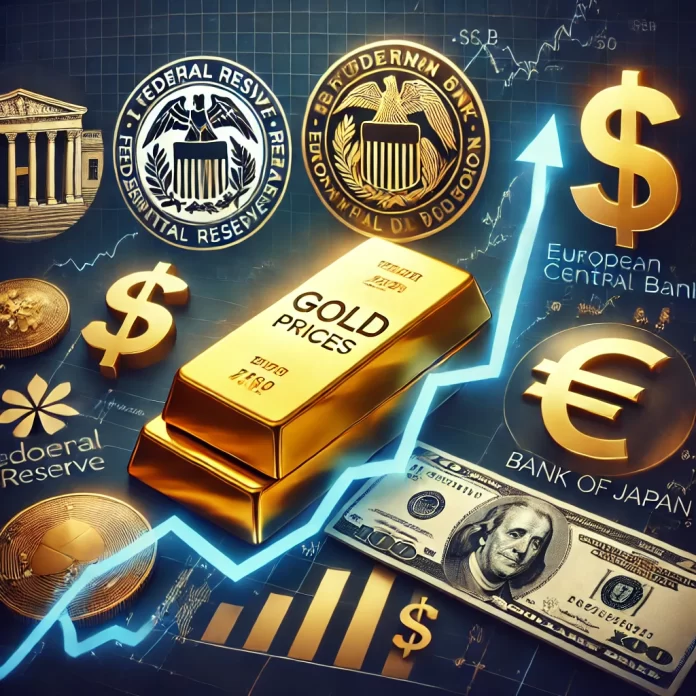Introduction
As global markets entered a highly anticipated week of central bank meetings, the US Dollar took a significant hit, and gold reached record highs. Investors are nervously awaiting key announcements from the Federal Reserve, European Central Bank (ECB), and the Bank of Japan (BoJ), all of which are expected to provide critical guidance on monetary policies, interest rates, and the future of global financial markets.
This article delves into the underlying causes of the US Dollar’s decline, the meteoric rise of gold, and how these movements reflect broader economic concerns. It also explores the potential impacts these central bank meetings may have on the currency and commodities markets.
The US Dollar’s Slide
In the days leading up to the central bank meetings, the US Dollar faced substantial downward pressure. A mix of factors contributed to the decline, including investor speculation that the Federal Reserve might signal a shift away from its aggressive rate hikes, which have defined much of its recent monetary policy.
Federal Reserve and Rate Cut Expectations
The central narrative driving the US Dollar’s depreciation is tied to expectations surrounding the Federal Reserve. Market analysts widely predict that the Fed will opt for a modest rate cut, or at the very least, signal a more dovish stance going forward. The prospect of looser monetary policy is typically bearish for a currency, as it can lead to a lower return on assets denominated in that currency.
Fed Chair Jerome Powell’s previous statements suggested that while inflation remains a concern, the central bank may start to prioritize economic growth, particularly given the slowdown in several key sectors. As such, traders are betting on a softer approach, which in turn has diminished the attractiveness of the Dollar for investors seeking yield.
US Economic Data Underwhelms
Recent economic data from the United States also played a role in weakening the Dollar. Retail sales, industrial production, and housing starts all posted softer-than-expected numbers in the weeks leading up to the central bank meetings. The disappointing data reinforced the notion that the US economy is cooling, prompting investors to hedge their bets and seek refuge in other assets, such as gold.
Global Sentiment and Risk Aversion
Moreover, the broader geopolitical landscape has fueled a flight to safety, with many investors shifting their capital away from riskier assets like equities and into safe-haven assets, particularly gold. The combination of geopolitical tensions in Eastern Europe and uncertainty surrounding the Chinese economy has further stoked risk aversion, contributing to the Dollar’s decline.
Gold Soars To Record Highs
As the US Dollar stumbled, gold experienced a remarkable surge, reaching record highs. Historically viewed as a safe-haven asset, gold often performs well in times of economic uncertainty, and the current environment is no exception.
Gold’s Safe-Haven Appeal
With concerns about the global economy growing, particularly in relation to central bank policies and inflation, gold has emerged as a beacon of stability for investors. Its intrinsic value and reputation as a hedge against inflation make it a highly attractive asset in times of market volatility.
As inflation fears persist, gold’s appeal increases. Investors expect central banks to either signal rate cuts or maintain dovish stances, which would likely support further rallies in gold prices. Moreover, with the Dollar’s weakness, gold becomes cheaper for buyers using other currencies, further boosting demand.
Technicals Support Gold Rally
Technically, gold’s breakout to record highs follows months of consolidation. Analysts have pointed to key resistance levels being breached, which has set the stage for further upward momentum. The next target for gold is seen at the $2,600 level, driven by both fundamental and technical factors.
Additionally, exchange-traded funds (ETFs) that track gold have reported significant inflows, indicating a growing appetite among institutional and retail investors to increase their exposure to the precious metal. This increased demand has only served to accelerate the rally, with gold prices projected to continue their upward trajectory as long as central banks remain dovish.
Central Bank Meetings: Key Drivers Ahead
The movements in the US Dollar and gold are largely anticipatory, with markets poised to react to the outcomes of major central bank meetings. The Federal Reserve’s decision will be the most closely watched, as it will provide critical insights into the future of US monetary policy.
Federal Reserve
If the Fed opts for a rate cut, or signals future cuts, it could further weaken the Dollar and push gold prices even higher. Conversely, if the Fed maintains its current stance or signals future rate hikes, we may see a reversal in these trends.
European Central Bank
The ECB is also expected to weigh in on its monetary policy, with markets looking for any hints of stimulus or rate cuts in response to persistently low inflation in the Eurozone. Any dovish tone from the ECB could add additional downward pressure on the Euro, potentially benefiting the US Dollar in relative terms.
Bank of Japan
The BoJ, meanwhile, faces its own unique challenges as it continues to struggle with deflationary pressures. While it has maintained ultra-loose monetary policies for years, analysts believe the BoJ may hint at new tools to combat economic stagnation. Any such measures could lead to significant movements in both the Yen and gold prices.
Conclusion
As the week of central bank meetings unfolds, the financial markets are likely to see heightened volatility. The US Dollar’s current downward trend and gold’s rally may continue if central banks confirm market expectations of dovish monetary policies. However, any surprises, particularly from the Federal Reserve, could shift these trends rapidly.
Investors are advised to keep a close eye on announcements from the Federal Reserve, ECB, and BoJ, as their decisions will undoubtedly shape the next phase of market movements. In the meantime, gold’s status as the preferred safe-haven asset appears to be solidified, while the US Dollar faces ongoing pressure in a challenging economic environment.
